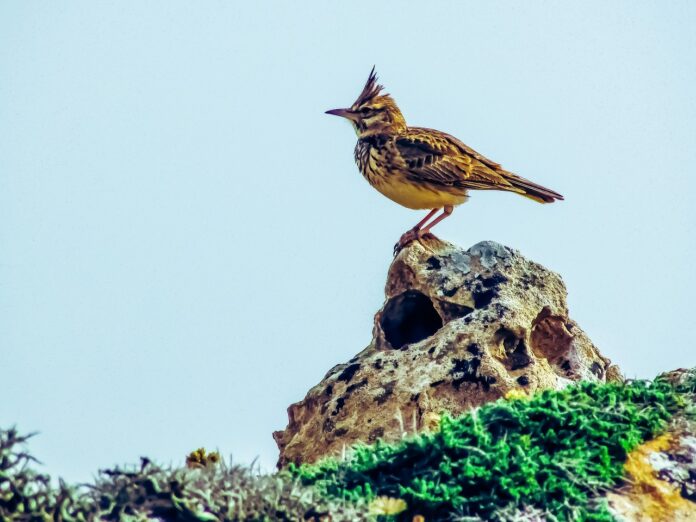The lark is rightly called the singer of the fields, as this is its home and natural habitat. There is a belief that it is the songs of these birds that awaken the earth to life after a long winter’s sleep. It’s no surprise, then, that the melodies of these small birds remind us that spring is on the calendar. Their clear trills can be heard from the first sunny days of March until the moment when the bird couple has offspring.
People are used to hearing these small, inconspicuous singers almost everywhere, so they don’t stand out much among other birds. However, there are 18 genera and 78 species of larks worldwide, each with its own unique characteristics.
Description
Larks, which look quite similar to sparrows, do not have a striking appearance. Their dull coloration makes them blend in perfectly. The color of a lark’s feathers matches the soil of the region where it lives. The young look a bit brighter than their adult counterparts, but not enough to draw attention. Their feathers on the head and back are mottled with dark edging, and the breast is a few shades lighter. They have large, cone-shaped, curved beaks. Their legs have “spurs”—finger-like projections with sharp claws.
Depending on the species, the average weight of a lark ranges from 30 to 70 grams, and their body length varies from 10 to 20 cm. Even experienced ornithologists find it difficult to distinguish between male and female larks, as they are identical in size and color. The only difference is their behavior.
Unlike many other birds, the lark does not appear graceful. Its head seems disproportionately large in relation to its body, while its legs seem very small. However, this awkwardness is deceptive. Once the bird takes to the air, it seems to transform. With its wings spread, the lark balances its small body, becoming the most perfect creature on earth. You can watch a lark’s flight endlessly, just as you can listen to its song.
These birds are surprisingly strong and enduring for their size. They can hover in the sky, singing for up to 8 hours with short, frequent breaks. However, when sensing danger, they drop like a stone to hide in dense ground vegetation. Larks have many natural predators, so nature has provided them with a unique defense mechanism—hiding in the grass. Accusing larks of cowardice would be unfair, though. A female lark will not leave her nest of eggs, even if a human is nearby. She will protect her future offspring until her last breath.
Habitat
Most species of larks are found in Europe, Asia, and Africa, but they can also be seen on other continents, such as in southern Australia and New Zealand. Thus, their habitat encompasses almost the entire world. These birds are highly adaptable to their environment; for instance, finch-larks can survive even under the scorching desert sun.
Most larks are migratory birds, flying to warmer, milder climates for the winter. They migrate south in flocks, making it easier to find food. By February or March, they return to their previous habitats. The males arrive first and set up homes for themselves, their potential mates, and future offspring.
Larks build their nests later than other birds, waiting for the young grass to sprout. This makes it easier for them to find secluded spots. They prefer fields sown with cereal crops or areas with tall grass. Sometimes, they build their nests in the roots of trees at the edge of a forest, but they never settle deep in the woods. Larks might even nest under rocks or in the branches of bushy plants like sagebrush.
With the right conditions, larks can be kept in captivity. To care for them, they need:
- A diverse, balanced diet,
- Clean, fresh drinking water,
- River sand for cleaning their wings,
- An optimal temperature (which varies slightly by species).
A lark’s singing is a sign of its comfort. In captivity, larks can live for 6 to 10 years, similar to their lifespan in the wild.
Interesting Facts
- Each lark has its own unique voice; no two are alike.
- Larks can mimic the voices of other birds, animals, and even human speech.
- Female larks rarely fly, preferring to move on the ground or incubate eggs. Males do most of the singing, and the higher they fly, the louder their songs.
- A lark’s song lasts no more than 10 minutes, after which it needs to rest.
- Lark chicks are born blind, but they develop rapidly, becoming fully grown within 25-30 days.
- Larks are skilled hunters. They prey on small insects, benefiting farmers and agriculture.
- To aid digestion, larks sometimes swallow small stones.
- Due to the structure of their legs, larks rarely perch on branches.
- Only one species of lark, the horned lark, is found in America.
- Instead of drinking water, larks consume morning dew, which is enough to maintain their moisture balance.
People believed that the field over which a lark’s song was heard would be fruitful. Each spring, they baked special bird-shaped pastries, giving them to loved ones with wishes for good health and a bountiful harvest. The lark was also believed to have mystical control over the sun and the ability to summon rain during droughts. For this reason, the lark is featured in many songs, proverbs, and sayings.
